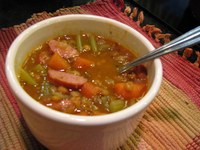Prairie Fare: Celebrate Soup Month With Comforting, Satisfying Soup
(Click the image below to view a high-resolution image that can be downloaded)
[Editors: Please use this version of Prairie Fare that has a correction in the recipe]
By Julie Garden-Robinson, Food and Nutrition Specialist
NDSU Extension Service
“I could use some help in the kitchen,” I said to my three kids who were on their phones or computers. I decided they needed to be dragged away from technology and immersed in real-life experiences.
My 19-year-old son somewhat reluctantly entered the kitchen. I set up a spot for him with bags of carrots and celery from the refrigerator, a colander to rinse them, a knife and cutting board.
I think I detected some discreet “eye rolling” from my son. However, he is quite clever at avoiding verbal commentary when his mother is in meal-management mode.
My 16-year-old daughter began peeling and chopping onions and mincing garlic. For some reason, her eyes are immune to the usual tear-inducing effects of flavorful onion bulbs, so she often is on “onion duty.” She began sautéing them with added spices and soon our kitchen was filled with delicious aromas.
My 11-year-old measured ingredients for whole-wheat bread dough in our bread machine to go with the soup. She has been making a different type of bread every week for several months, so this was “easy peasy.”
My husband wandered by to see what was cooking. We were “fully staffed” in the kitchen, so he meandered into another room in anticipation of a delicious meal.
What was left for me to do besides overseeing my culinary squad? I prepared the lentils, the easiest job of all. All I had to do was sort the lentils in case there were any stones or other debris present. Then I put them in a bowl and covered them with boiling water.
I have been incorporating more lentils in our meals because they are high in fiber and good sources of protein, vitamins and minerals. They also are very inexpensive and take very little time to prepare.
Soon we had flavorful soup simmering and the sound of bread dough mixing in the bread machine. Having eight hands busy in the kitchen made the process go quickly, plus we were doing our part to celebrate January, National Soup Month. I think they had fun, too.
I could live on soup any time of the year but especially during the cold winter months. I have many favorite recipes, but I also like to try new ones or new renditions of old ones. Sometimes I just make up a soup recipe with what I have in my refrigerator and pantry following the “7 Steps to Creating a Soup” handout that is available at http://www.ag.ndsu.edu/pubs/yf/foods/fn1648.pdf.
As researchers have shown, we all could benefit from eating more soup, especially if one of our New Year’s resolutions is to maintain our current weight or lose a few pounds.
In a study reported in the journal Appetite, Pennsylvania State University researchers provided various types of soup followed by entrees to 35 women and 38 men. They wanted to see how soup consumption before a meal, which they termed a “soup preload,” affected the number of calories consumed by the participants in the overall meal.
They monitored how much food was eaten and asked the participants to rate the quality of the food and their own satiety.
The researchers found that having soup before a meal can take the edge off your appetite. In fact, their research participants cut the total amount of calories they consumed by 20 percent, compared with participants who had no soup.
Instead of soup, can’t you just eat some vegetables and drink some water? Soup tends to make you feel more satisfied. Other researchers have reported that vegetable soup may make you feel “fuller” than the raw vegetables served with a glass of water.
Some soups can be quite high in calories, so go for the ones with plenty of low-calorie vegetables and types made with broth instead of cream. Also, take steps to reduce sodium by choosing lower-sodium ingredients, such as low-sodium broth, and cutting back or leaving out the added salt.
Here’s the soup made by the Robinson kids with great accolades from their dad. They liked it, too. Check out http://www.ag.ndau.edu/food for more soup recipes. Check out the link to our “Nourishing Boomers and Beyond” program materials and Facebook page, too.
Lentil-kielbasa Soup
8 ounces lentils (uncooked)
3 Tbsp. cooking oil (olive, canola, sunflower, etc.)
2 c. onions, chopped
2 tsp. garlic, minced
1 tsp. dried thyme
1/4 tsp. cumin
2 c. carrots, cut in small chunks
2 c. celery, cut in small chunks
1 1/2 quarts chicken broth (homemade or canned), reduced-sodium
2 Tbsp. tomato paste
14 ounces kielbasa sausage (reduced-fat)
Sort and rinse the lentils. Remove any stones. Place the dry lentils in a bowl and cover them with boiling water. Allow to stand while you prepare the remaining ingredients. In a large stockpot, heat the oil, then add the onions, garlic, thyme and cumin. Cook until the onions are translucent. Add the carrots and celery and sauté for about 10 minutes. Add the chicken broth, tomato paste and lentils and bring to a boil. Reduce heat. Allow to simmer uncovered for about an hour. Add the kielbasa and simmer until the kielbasa is hot. Serve.
Makes 10 servings. Each serving has 180 calories, 11 grams (g) of fat, 10 g of protein, 9 g of carbohydrate, 3 g of fiber and 710 milligrams of sodium.
(Julie Garden-Robinson, Ph.D., R.D., L.R.D., is a North Dakota State University Extension Service food and nutrition specialist and professor in the Department of Health, Nutrition and Exercise Sciences.)
NDSU Agriculture Communication – Jan. 8, 2015
| Source: | Julie Garden-Robinson, (701) 231-7187, julie.garden-robinson@ndsu.edu |
|---|---|
| Editor: | Rich Mattern, (701) 231-6136, richard.mattern@ndsu.edu |


